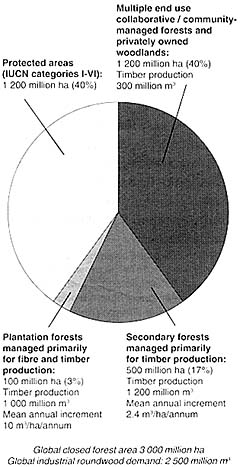Global Vision
for Forest 2050
project
Gary Bull is in the Faculty of Forestry and the
Liu Centre of Global Issues, University
of British Columbia, Vancouver, Canada.
John Spears is Senior Environmental
Advisor, Alliance for Forest Conservation
and Sustainable Use, World Bank, Washington,
DC, United States.
The Global Vision for Forest 2050 project is an attempt to build more effective links among the multiple objectives of forest management, including:
The vision is for a landscape-based forest use regime that deals with competing land uses by apportioning the natural forest into three distinct categories (see Figure). For example:
Naturally the details would vary from country to country according to the ecological, social, political and economic conditions. A scheme for Canada has been proposed, for example, by the Canadian Senate Subcommittee on the Boreal Forest.
The project is currently organizing a research programme in conjunction with key members of the international forestry community. Such research will have at least three principal benefits:
These are just a few of the issues that the Global Vision research project will begin to tackle:
Protected areas
Timber production areas
Non-industrial forestry
A possible global forest situation by year 2050(1)

The Global Vision project will provide a forum for comprehensive discussions among a wide range of international and research agencies. Participating institutions currently include FAO, the World Bank, the Worldwilde Fund for Nature (WWF), the International Institute for Applied Systems Analysis (IIASA), the Center for International Forestry Research (CIFOR), the Council on Foreign Relations, the World Resources Institute (WRI), the Canadian International Development Agency (CIDA), the Canadian Forest Service, the European Forest Institute (EFI), and the Liu Centre for Global Issues and the Faculty of Forestry of the University of British Columbia, plus a host of research agencies in developed and developing countries. Experts in a wide range of disciplines from more than 30 countries, including those in the tropics and those in Eastern European, participated in a meeting held in October 2000, and more countries are expected to join in the subsequent months.
For more information contact: Gary Bull
Faculty of Forestry and the Liu Centre for Global Issues - University of British Columbia - Vancouver, BC, Canada - url: www.oneforest.org
1 In all four categories of forest land use depicted in this chart, including timber and fibre production forest, it is assumed that objectives of management will incorporate preservation of biodiversity and other environmental benefits.